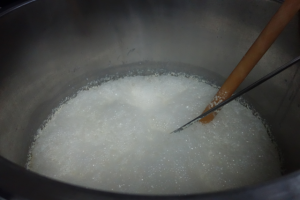Published: Jan 30, 2014 by Joe Larabell
To anyone who knows me, it should come as no surprise that I enjoy Japanese Sake (also known as Nihon-shu in Japanese to distinguish it from sake, the Japanese word for alcoholic beverages in general). Living in Japan puts me in almost constant contact with a steady stream of new brands as most restaurants which are serious about Sake make a point to bring new ones in pretty much every week. There are at least three restaurants in my immediate neighborhood where the staff knows that my preference is to drink something I haven’t had before. At this point, I don’t even need to look at the menu any more. So it seems only logical that I would eventually find myself in John Gauntner’s Sake Professional Course.
 The course was everything I expected it to be. Five full days of nothing but Japanese Sake… until we were all practically breathing the stuff. The first three days were composed of lectures. The motto of the course is: “no sake stone left unturned” and that’s the plain truth. From styles and grades, to ingredients, to the entire brewing process, to oddball “just-barely-sake” styles, even to the current market outlook. I now feel like I can speak intelligently on just about any aspect of the subject.
The course was everything I expected it to be. Five full days of nothing but Japanese Sake… until we were all practically breathing the stuff. The first three days were composed of lectures. The motto of the course is: “no sake stone left unturned” and that’s the plain truth. From styles and grades, to ingredients, to the entire brewing process, to oddball “just-barely-sake” styles, even to the current market outlook. I now feel like I can speak intelligently on just about any aspect of the subject.
But that’s not all. After each morning and afternoon lecture, there was a tasting period where John brought in various brands of Sake that demonstrated the principles we had just learned. We got to taste the effects of the type of rice used, the effects of how the rice was milled, the effects of subtle differences in the brewing process. Even though, by the time I took the course, I had experienced some 200+ brands of Sake over the years, this kind of “controlled tasting” was definitely a new experience for me. All told, counting the Sake introduced during the course and what we drank with dinner each night (yes… dinner was included every night), I counted just over 100 different brands of Sake.
 But that’s still not all. During the final two days we visited four breweries in the Kansai area (Kyoto, Kobe, and Osaka). The breweries were carefully chosen to represent both the smallest and the largest in terms of scale, as well as the brewery that makes Eikun and who managed to win Gold medals in the national tasting competition 14 years in a row. Of course, each brewery put out a line of its best products for tasting, bringing the total number of Sake products we tasted that week to somewhere around 130.
But that’s still not all. During the final two days we visited four breweries in the Kansai area (Kyoto, Kobe, and Osaka). The breweries were carefully chosen to represent both the smallest and the largest in terms of scale, as well as the brewery that makes Eikun and who managed to win Gold medals in the national tasting competition 14 years in a row. Of course, each brewery put out a line of its best products for tasting, bringing the total number of Sake products we tasted that week to somewhere around 130.
But there’s more… An exam is included as part of the course and, having passed same, I am proud to count myself among the 1000-or-so alumni of this course who have become Certified Sake Professionals. But even though the course was centered around Sake, it was also about people. This year saw 27 people from 11 countries attend the course and by the end of the five days I felt like I had met 27 Sake-drinking soul-mates. That alone (and the parties every evening, of course) would have made the course worth it for me. What I learned about Sake along the way was icing on the cake.
My thanks go out to John Gauntner (http://www.sake-world.com/) for pulling all this information together. Before him, there was precious little information in English about Sake (and not all that much in Japanese, either, from what I understand). The Sake industry and all Sake lovers owe him a great debt. Check out his website and, if it be your Will, order up a round of Sake the next time you see it on the menu. I’m sure you won’t regret it.
This post was originally published as: https://larabell.org/wordpress/2014-sake-professional-course/
Comments:
The Disqus comments section is currently under evaluation. You should not have to be logged in to post a comment. If you have any trouble or see anything strange in this section, please let me know. Thanks.
Legacy Comments:
The comments in this section were imported from the original WordPress post. If further comments are enabled for this post, you should find a Disqus form directly above this legacy comment section.
Doug Warmke (2014-01-30):
Is there an SPC Level II in your future, Joe? ;^)
Joe Larabell (2014-01-30):
Most likely. Level II, from what I understand, deals more with tasting than theory.